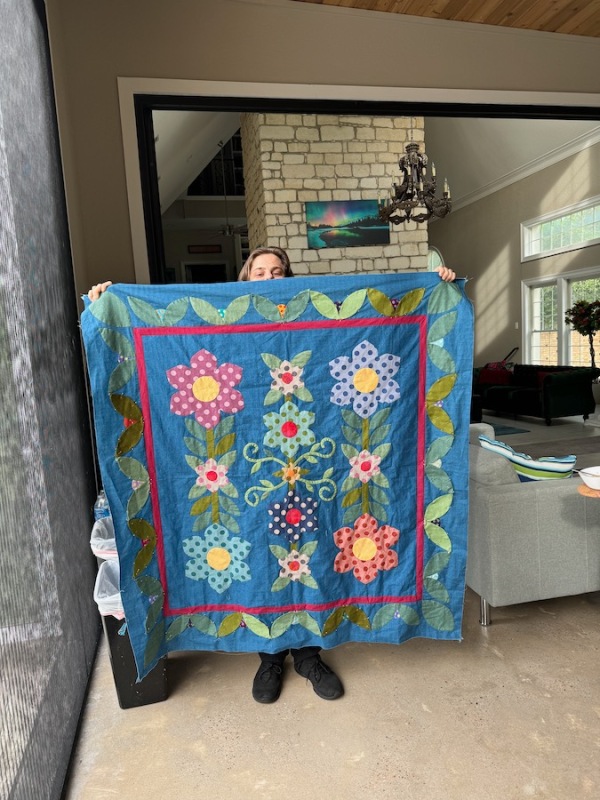(And some other stuff)
I’m not by nature a terrifically tidy sewer, preferring to let my (ahem) creativity spill all over when I stitch. But doing one of those collage quilts where you iron on the fusible interfacing then layer it up, is a new level of Mess. I will clean it up when I’m finished, but here’s where I am now. I started this because the Utah Valley Quilt Guild (I’m a proud member, just too far away) hosted Emily Taylor, aka the Collage Quilter, as I mentioned in this post.


cherries! BEFORE
Yep, it was a total fail. Because Steam-A-Seam is like working with plastic, I just peeled all that stuff off and started again…with fewer fabrics. Or, as Mies van der Rohe used to say, “less is more.” Boy, howdy, but maybe not in these fruits.

I got the hang of it on these strawberries. It seems like every time I switch to a new fruit, there is a new learning curve.

All the watermelon sections finished. I read all sorts of cautions about not pressing them TOO much before they are on the fabric, so these are sort of tacked down and lightly pressed.

The fabric selection for the center proceeds apace, with the lower three fabrics picked up in Utah, when I went up there for Dad’s memorial. The cross weave pattern on the fabric on top was the right scale, but too burgundy-ish and cream-ish to be right. I like the second one — a bias-printed plaid — a lot (especially the colors) but was worried the scale might be wrong. It’s a good backing or binding fabric, though. Daisies are in the running, but am leaning to the fourth one down: the double-plaid. My brain is on auto-pilot now and that’s what the pattern designer had. Fine. I’ll do whatever’s on the pattern (haha).

Next up are peaches, pears and grapes, and happily my friend Susan of PatchworknPlay sent me her beautiful watercolor so I could figure out pears. Then we’ll see about putting it all together.
We left very early in the morning to fly up to Utah and arrived well before the time the memorial would start. So we spent some time walking around the plaza near Temple Square in Salt Lake City, admiring the flowers (below). While I loved the tulips (multiple varieties and colors), I also loved these little ones at the end, which look like a cross between a daisy and a baby mum. Anyone know what they are?




Since you’ve already seen a photo of my dear aunts, here’s another one of us with my sister Christine, an artist from New York, just after the memorial. My sister Susan talked, as did two of my brothers, Andy and Scott. We also heard from three grandchildren.

After the memorial and the family luncheon arranged by my lovely sister Cynthia, I went to my son’s, where I found my granddaughter deep in T-shirt-quilt construction. She’d watched a YouTube video, gone to JoAnn’s to get interfacing and figured it out. She’s like that. And…after trying to help her cut the strips for the sashing, we went to JoAnn’s to get a new cutting mat, new rotary cutter and a couple of rulers. (I told her to hide them from her family.)

We went in her Tesla and she showed me some of the modes on her screen, including one where you can embarrass your friends. She also used Auto-Drive, or whatever it is called, to get us to JoAnn’s. I was alternately freaked out as well as thinking: this could come in handy when I’m older!

Later, she sent me a photo of her completed first quilt, her voice on the phone full of excitement.

Homeward bound later that night, I took photos out the airplane window, a time-honored practice. I had really struggled all week with getting the layering of shadow and light in the fruits I was making, and in looking at this nighttime scene, I thought it would be good practice to try to figure out where shadows are delineated, and where light glows through the dark.
I thought about the talks at my father’s memorial, the stories from his grandchildren and his children about how his life was — how our lives are — a combination of light and shadow. But the lessons we learn as we travel through these darker places teach us humility, strength, and the power of saying “I’m sorry,” as well as the incalculable blessing of forgiving one another (and ourselves) for failures.
I once titled a quilt: “Shadow Owes Its Life to Light.” We have no shadows that aren’t connected to light. Light, as heard in my granddaughter’s voice, when she finishes her T-shirt quilt top. Light, when watching my niece Brittany cuddle her new baby. Light, when my sister-in-law Julie, who nearly died last year, is sitting at the table, telling us stories about her students. Or my 92-year-old aunt, all of five feet, lighting up a conversation with younger nephews, the young men towering over her.

Oh, how I will my miss my father, just as I have missed my mother!
May their memories be a blessing for life in the world to come–
(from here)


the view from 35,000 feet.









































































